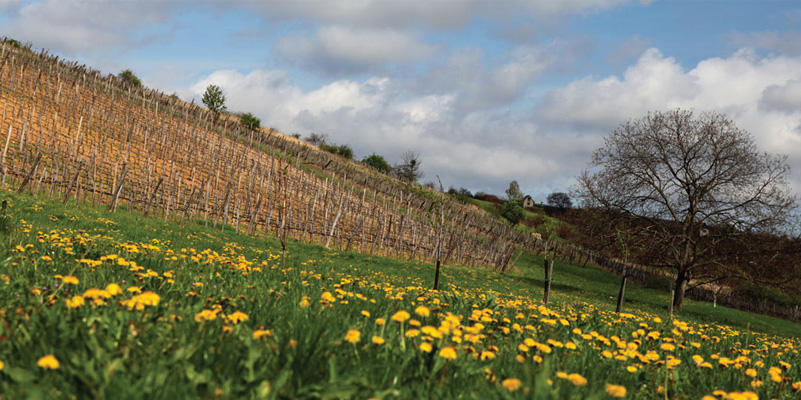“Imagine the vineyards of the Côte d’Or being ripped out or abandoned, and then witnessing their rebirth,” says Jeff Berlin, wine director at À Côté in Oakland, California. He’s describing the excitement he feels watching Hungary’s Tokaj region recover a er a half-century of Soviet rule.


Berlin first discovered Tokaj about a decade and a half ago when a supplier stopped in to pour him some of the region’s famous sweet aszú wines, as well as the then-new dry furmints. “They were absolutely stunning, on par with the great white wines of the world,” he says. And he found the wines, both dry and sweet, to be exceptionally fun to pair with food; an Oremus dry furmint with Serrano ham, Sharlyn melon, radicchio and mint went down as his most exciting food and wine pairing of 2003. Ever since, he’s been such a supporter of the wines that the Tokaj Borlovagrend recently inducted him into its brotherhood.
Although Tokaj is home to several grapes, Berlin thinks of the native furmint as the region’s “ambassador.” He describes the energy and spice that the wine picks up in Tokaj’s volcanic and loess vineyards as “a powerful current of electric acidity, like a Tesla coil in every bottle.” Since most aszú wines are blends of both vineyards and varieties, he proposes focusing on dry versions—especially single-vineyard bottlings—to get a clear view of the grape and its varied expressions.


1. Hétszölö Dry Furmint
On pure historical account, Hétszölö deserves to be in the lineup, Berlin says. “The estate dates back to 1502, and kings and queens of Hungary were crowned in Hétszölö’s Ráckoczi cellar.” Berlin places this
wine at the more elegant and refined end of the dry furmint spectrum thanks to the thick loess soils of the estate’s vineyards on the southern slopes of Kopaszhegy (Mount Tokaj), rarer than the volcanic clay that dominates the rest of the region. “It makes for a young, fresh, bistro style,” he explains, likening its flavors—“fresh pears and honeydew melon, acacia flowers, wild herbs, lemon peel”—and honeyed texture to young Vouvray, while a touch of petrol hints at dry Mosel riesling.
2. Bodrog Bormühely Halas Furmint
This wine, Berlin says, represents a riper, fruitier expression of furmint. The Halas vineyard, which once belonged to co-owner János Hajdu’s grandfather, is a warm, south-facing parcel that slopes down to the Bodrog River in the village of Bodrogkisfalud, and its 50-year-old vines grow in rich red volcanic clay. “These factors combine to make fat, happy furmint grapes and round, juicy mouthfuls of wine,” Berlin explains. “But the wine also demonstrates how the volcanic minerality and naturally high acidity of furmint can support a fuller, richer style.”
3. Demeter Zoltán Veres Furmint
This is the winery that first hooked Berlin on Tokaj, he says, remembering back to when importer Frank Dietrich stopped in the restaurant to pour him some tastes. “They were absolutely stunning; I can still remember the taste and personality of each.” Veres comes from 30-year-old vines grown on rhyolitic [volcanic] tufa scattered with an abundance of light, porous, honeycomb-like stones. It’s one of the original “great growths” listed in Tokaj’s 18th-century vineyard classification. Demeter vinifies exclusively in steel to highlight the parcel’s vocation to yield furmint with uncommon delicacy allied to power. “It’s amazing how richness is balanced by minerality and the raw energy of furmint’s acidity,” he says. “It’s like getting lost in a labyrinth, the flavors weaving through orange flower honey, hazelnut butter, peach and marzipan tart, quince and lilac aromatics, among others.”
4. Szepsy Szent Tamás Furmint
“I’d shell out for a bottle of Szepsy Szent Tamás quicker than for Montrachet. It’s one of the finest wines on the planet,” says Berlin. It’s made by local legend István Szepsy, whose family has been making Tokaji since the 16th century, and whose ancestor is credited in part with the original aszú recipe. The contemporary Szepsy is credited with producing Tokaj’s first truly great, dry, single-vineyard furmint, the 2000 Úrágya. This bottling comes from the Szent Tamás vineyard, which, although not dramatic in appearance, is considered the greatest of the 18th-century great growths in Mád, with a kaleidoscopic array of red, yellow, green and white rhyolite tufa, and weathered zeolite. It’s one of Szepsy’s most ageworthy crus. “The complexity is unparalleled,” Berlin says. “Only German compound nouns come close to matching it. Considering the ripeness—o en close to 15 percent alcohol—what you might believe will be dense and sweet is actually one of the most balanced, fully dry, and structured white wines of all.”
5. Samuel Tinon Dry Szamorodni
“Dry szamorodni is a unique jewel,” says Berlin. He’s referring to a now-rare style made from a mixture of healthy and botrytised grapes: szamorodni means “as it comes” in Polish, and the percentage of botrytis determines whether the wine finishes dry or sweet. The wine is aged highly oxidatively, in some cases under a veil of yeast, as for vin jaune or Sherry. Samuel Tinon, a Frenchman who arrived from Bordeaux in 1991 to manage the Royal Tokaj Wine Co., later struck out on his own in large part to champion the style. “The addition of botrytis and Cladosporium cellare, a mold found in the cellars of Tokaj, creates endless dimensions,” Berlin says. “The 2007 is still very much in its youth but already shows a mind-blowing amount of complexity, a full spice rack of exotic aromatics and the scents of forest floor after a rain, all li ed up by the fresh acidity of a ripe, juicy nectarine.”
6. Patricius Aszú 5 Puttonyos
Despite Berlin’s enthusiasm for Tokaj’s dry furmints, he concedes that sweet botrytis- affected aszú wines “are the soul of the region.” He highlights the Patricius 2004 Aszú 5 Puttonyos here in part for the value it offers, but also as a prime example of the great balance achievable in the region. “It redefines how fresh aszú wines can be,” he says, noting the formidable acidity and massive dry extract that o sets high residual sugar. The balance comes in part from vintage character, but also from Patricius’ collection of exclusively great growth–classified vineyards. Winemaker Péter Molnár also soaks his aszú berries in still-fermenting base wine, as opposed to fresh must or finished wine, a subtle technical difference, that, according to Molnár, provides the most effective extraction of aromas, sugar and acids, while enhancing both creaminess and minerality. “The botrytis-influenced aromatics also play off the floral, fresh-picked stone and citrus fruit notes,” Berlin offers. “With savory dishes such as foie gras, charcuterie, prosciutto and
melon, aszú works brilliantly.”
This story was featured in W&S Fall 2016.
illustration by Veronica Collington
John Szabo, MS, has been traveling to Hungary since the late 1970s—first to visit relatives, and later to start J & J Eger Wine Co., where he makes kékfrankos with partner János Stumpf. But his day job is writing about wine and researching the world’s best wine bars.
This story appears in the print issue of fal 2016.
Like what you read? Subscribe today.
















